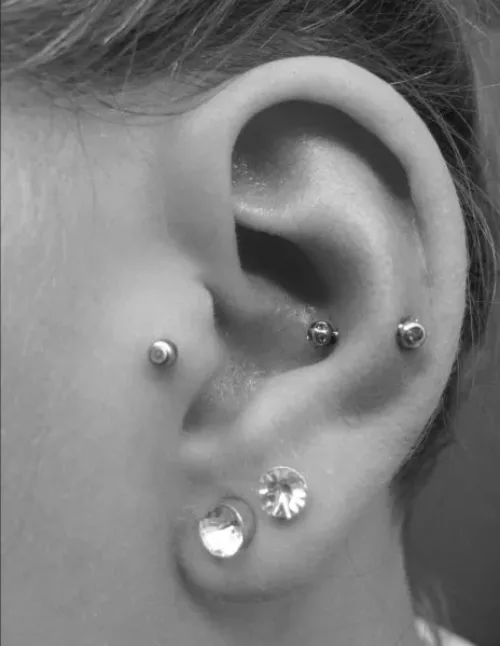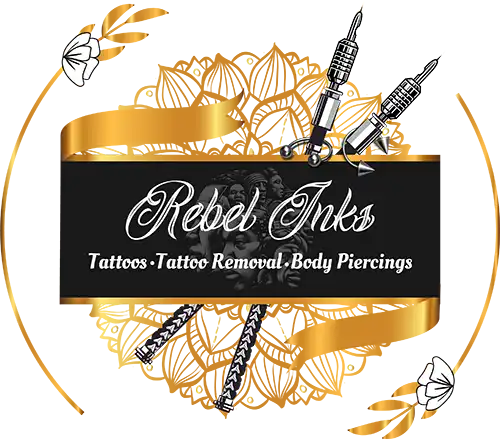Snug Piercing in Nairobi, Kenya
A snug piercing is a unique, stylish choice that stands out from typical ear piercings. It goes through the cartilage ridge along the inner ear, known as the anti-helix, and is known for its edgy yet subtle look. Since the snug piercing is done on thicker cartilage, it can be a bit more sensitive than other ear piercings and might take longer to heal—typically between 6-12 months, depending on aftercare and personal healing.
Snug Piercing
Snug Piercing Procedure
The snug piercing procedure is precise and requires an experienced piercer due to the unique placement on the anti-helix cartilage. Here’s what to expect:
Procedure Steps:
- Preparation and Consultation: Our piercer will clean the area thoroughly and assess your ear structure to ensure it’s suited for a snug piercing. Since the snug piercing is anatomically restrictive, the piercer might suggest alternatives if the anatomy isn’t ideal.
- Marking: After discussing placement, our piercer will mark the entry and exit points on the cartilage to ensure accuracy and symmetry.
- Sterilization: All equipment is sterilized, and our piercer will wear gloves to maintain a clean environment, minimizing infection risks.
- Piercing: Our piercer will use a sterilized, hollow needle specifically designed for piercing cartilage. They’ll create the hole by piercing through the anti-helix ridge, which can cause a moment of sharp pain. The snug piercing often feels more intense than lobe piercings due to the cartilage’s density.
- Jewelry Insertion: Typically, a straight barbell or curved barbell is inserted right after the piercing, as these help reduce pressure on the cartilage during the healing process.
- Aftercare Instructions: Our piercer will provide thorough aftercare guidelines, such as using saline solution for cleaning, avoiding physical contact, and sleeping on the opposite side to prevent irritation.
Since cartilage piercings can be prone to swelling and take longer to heal (6-12 months), following these instructions is crucial for a smooth healing process.
Considerations before getting a Snug Piercing
Before getting a snug piercing, here are some key considerations to ensure it’s the right choice for you:
- Ear Anatomy Suitability: Not everyone’s ear anatomy is ideal for a snug piercing. The anti-helix ridge needs to be pronounced enough to hold the jewelry comfortably. At Rebel Inks Tattoos, Tattoo Removal, and Body Piercings Parlour we have professional piercers who can assess if your ear structure can accommodate this piercing.
- Pain Level: The snug piercing is known to be more painful than other ear piercings since it goes through thick cartilage. Pain tolerance varies by person, but it’s good to be prepared for a sharper sensation during the procedure and some lingering soreness afterward.
- Healing Time: Cartilage piercings generally take longer to heal—6 to 12 months for a snug piercing. During this time, it requires extra care to avoid irritation or infection. A longer healing period means more commitment to aftercare.
- Risk of Complications: Cartilage piercings, snug included, can be prone to complications like keloids, bumps, or infections if not cared for properly. Follow all aftercare instructions provided by the piercer to reduce these risks.
- Jewelry Choices: Initial jewelry often includes a straight or curved barbell to minimize irritation, but once healed, you may switch to other styles. Keep in mind, however, that changing jewelry prematurely can delay healing or cause irritation.
- Professional Piercer: Due to the snug piercing’s precision, it’s essential to visit an experienced piercer who understands cartilage anatomy. This reduces the risk of incorrect placement, trauma, and complications. At Rebel Inks Tattoos, Tattoo Removal, and Body Piercings Parlour we have a team of experienced and seasoned piercers.
- Lifestyle Adjustments: Think about any activities that might interfere with the healing process. For instance, sleeping on the side with the piercing, wearing headphones, or engaging in sports can put pressure on the piercing and slow down healing.
If you’re committed to the aftercare and feel comfortable with the unique requirements of a snug piercing, it can be a beautiful addition!
Snug Piercing Pain and Healing
The snug piercing is often regarded as one of the more painful cartilage piercings due to its placement in a thick, dense section of the ear cartilage. Here’s what to expect with pain and healing:
Pain Level
- During the Piercing: Many describe the initial piercing as a sharp, intense pain since the needle goes through thicker cartilage, which has more resistance than softer parts of the ear.
- After the Piercing: It’s common to feel soreness, throbbing, or aching immediately after. The pain typically subsides within a few days to weeks but can persist longer for some.
Healing Process
- Healing Time: Snug piercings take anywhere from 6 to 12 months to fully heal. Healing can vary widely depending on aftercare and individual healing responses.
- Initial Swelling: Expect some swelling in the first few days. Applying a cold compress can help reduce this, but avoid pressing directly on the piercing.
- Stages of Healing:
– Weeks 1-2: Expect initial soreness, redness, and some swelling.
– Months 1-3: The piercing might feel sensitive or slightly sore to the touch but should show signs of improvement with proper care.
– Months 3-6: The snug should feel more stable, but it may still be vulnerable to irritation or infection if bumped or handled excessively.
– Months 6-12: Full healing typically completes by the end of this period, though cartilage takes longer than soft tissue to fully solidify around the jewelry.
Snug Piercing Aftercare
Aftercare is essential for a snug piercing, as it goes through dense cartilage and requires more time and attention than lobe piercings. Here’s a detailed aftercare guide to help ensure smooth healing:
- Daily Cleaning Routine:
– Saline Solution: Clean the piercing twice daily with a sterile saline solution. You can make this at home by dissolving 1/4 teaspoon of non-iodized sea salt in 1 cup of warm distilled water.
– Application: Gently soak a clean cotton pad in the saline solution and apply it to the front and back of the piercing. Avoid scrubbing or rubbing, which can irritate the skin.
– Avoid Alcohol or Peroxide: Harsh solutions can dry out the area, delay healing, and cause irritation. Stick to saline for gentle cleansing. - Avoid Touching or Twisting: Touching the piercing with unwashed hands or twisting the jewelry can introduce bacteria and delay healing. Let the jewelry move naturally without handling it unnecessarily.
- Protect from Physical Irritation:
– Sleep Carefully: Sleep on the opposite side to avoid putting pressure on the piercing.
– Avoid Headphones and Helmets: Over-ear headphones, hats, or any equipment pressing on the ear should be avoided as much as possible during healing.
– Be Mindful of Clothing and Hair: Scarves, hairbrushes, and loose hair can snag on the jewelry, so take extra care. - Manage Swelling:
– Cold Compress: If swelling occurs, apply a cold compress (like a clean ice pack wrapped in a cloth) near the area for short intervals.
– Avoid Anti-Inflammatory Medications: Avoid aspirin, as it can thin the blood and increase swelling. Ibuprofen or acetaminophen can be taken for pain relief but should be discussed with a healthcare provider if needed. - Be Patient with Healing:
– Healing a snug piercing typically takes 6 to 12 months. Cartilage piercings are slower to heal, so be consistent with aftercare and gentle with the area.
– Avoid Changing Jewelry: Wait until the piercing is fully healed before switching jewelry. Changing it prematurely can lead to irritation or infection. - Signs of Potential Issues:
– Infections: Redness, swelling, warmth, or unusual discharge might indicate an infection. Clean the area gently and consult a professional piercer or doctor if symptoms worsen.
– Bumps or Keloids: Sometimes, irritation bumps or keloids (raised scars) can form. This can often be minimized with proper aftercare, but if bumps develop, speak to a piercer for specific advice.
By following these steps, you can help ensure a smooth healing process and minimize the risk of complications.
Snug Piercing Jewelry
Choosing the right jewelry for a snug piercing is essential for both comfort and style, especially given the unique placement on the anti-helix. Here are some popular jewelry options and considerations for snug piercings:
Initial Jewelry Choice
- Curved Barbells: Often recommended for initial healing, curved barbells place less pressure on the cartilage compared to hoops. They reduce the risk of irritation and offer a clean, minimalist look.
- Straight Barbells: Another common option, especially if a more minimal, edgy look is preferred. However, some people find curved barbells more comfortable as they mimic the natural curve of the ear.
Long-Term Jewelry Options
- Hoops and Captive Bead Rings (CBRs): Once healed, snug piercings can be styled with small hoops or captive bead rings. These can add a bold look but may increase irritation if not fully healed or if they are too small.
- Segment Rings: These rings are smooth and don’t have an opening like CBRs, which can make them more comfortable for everyday wear in healed snug piercings.
Jewelry Material Considerations
- Titanium: Highly recommended for initial piercings due to its hypoallergenic nature. Titanium is less likely to cause irritation or reactions and is lightweight, which can aid the healing process.
- Surgical Steel: Common and durable, surgical steel is also hypoallergenic, but some people with metal sensitivities prefer titanium to avoid any risk of irritation.
- Niobium: This metal is a good alternative for those sensitive to other metals, as it’s highly biocompatible and available in a variety of colors.
- Gold: Solid 14k or 18k gold can be worn once the piercing is fully healed. Avoid gold-plated jewelry during healing, as the plating can wear off, causing irritation or infections.
Jewelry Size and Gauge
- Gauge: Snug piercings are commonly pierced at 16-gauge (1.2mm) or 18-gauge (1mm), depending on ear anatomy.
- Diameter and Length: For initial piercings, a slightly longer barbell may be used to accommodate swelling. For hoops, a snug fit is ideal, but your piercer can advise on the best diameter based on your ear anatomy.
Changing Jewelry
It’s crucial to wait until the piercing is fully healed (6-12 months) before changing jewelry. Changing it prematurely can disrupt healing and lead to irritation or infection. Always consult a professional piercer if you’re unsure about the timing.
Snug piercings look striking with the right jewelry and, with careful selection, can be a comfortable addition to your piercing collection.
Cost of a Snug Piercing in Nairobi, Kenya
The cost of a snug piercing can vary based on several factors, including the studio’s location, the piercer’s experience, and the jewelry selected. Here’s a general breakdown:
- Average Cost Range:
– At Rebel Inks Tattoos, Tattoo Removal, and Body Piercings Parlour typically, a snug piercing costs between Ksh. 1,500 and Ksh. 2,5000. This may or may not include jewelry, depending on the material and type. - Jewelry Cost:
– Basic Jewelry: Jewelry included with the piercing is often simple and made of safe materials like titanium or surgical steel. This usually costs an additional Ksh. 300 to Ksh. 800 if not included in the base price.
– Premium Jewelry: Higher-end options like gold or niobium can raise the price. Gold jewelry may cost anywhere from Ksh. 1,000 to Ksh. 5,000 or more, depending on the quality and design. - Piercer’s Experience:
Highly skilled or experienced piercers often charge a premium for their expertise, especially for complex piercings like the snug. This can add to the overall cost, but experienced piercers can also help reduce complications by ensuring correct placement. At Rebel Inks Tattoos, Tattoo Removal, and Body Piercings Parlour we have team of seasoned and experienced piercers. - Additional Fees:
At Rebel Inks Tattoos, Tattoo Removal, and Body Piercings Parlour we might charge a separate consultation fee or aftercare products fee, Get in Touch with one of our professional piercers to confirm what’s included when booking.
Investing in a reputable, licensed studio is recommended to ensure a clean, safe piercing environment and a quality result.
Possible side effects of Snug Piercing
A snug piercing, while stylish, can have potential side effects due to its location on thick cartilage. Here are some possible side effects and how to manage them:
- Pain and Swelling
– Pain: It’s normal to experience initial soreness and throbbing, but excessive or prolonged pain could indicate irritation.
– Swelling: Some swelling is common in the first few days. Applying a cold compress can help reduce swelling, but avoid putting direct pressure on the piercing. - Infection
– Signs: Redness, warmth, prolonged pain, or yellow/green discharge may signal an infection.
– Prevention: Avoid touching the piercing with unwashed hands, follow aftercare, and clean it twice daily with saline solution. If signs of infection appear, consult a professional piercer or doctor. - Hypertrophic Scarring and Keloids
– Hypertrophic Scarring: These are raised bumps that can form due to irritation. They often resolve with proper care but may need additional treatment.
– Keloids: For some, especially if prone to keloids, the body may form raised scar tissue around the piercing. Keloids may require medical treatment, so consult a professional if they develop. - Piercing Bumps: Often caused by irritation or trauma, bumps may form around the piercing. Keeping the area clean and avoiding trauma can help prevent them.
- Migration or Rejection: Though rare with snug piercings, migration (movement of the jewelry) or rejection can happen if the body starts to push the jewelry out. If you notice the jewelry shifting position, seek advice from a piercer.
- Delayed Healing: Snug piercings typically take 6-12 months to heal, but factors like poor aftercare, frequent touching, or sleeping on the piercing can delay the process.
Being mindful of aftercare and avoiding unnecessary pressure on the piercing are the best ways to minimize these risks.
Get In Touch
For more information on the list above and any other special services,please call or come in for free consultation
Testimonials
Shout out to Eric😘
We ended up changing the jewelry three times to ensure I had the best fit and avoided any signs of rejection, and he always listened to my suggestions as a client, which I really appreciated. Now, three months in, my piercing is healing beautifully, with no sign of rejection. Highly recommend for anyone who values a piercer who cares about your comfort and healing journey!
The piercing wasn't as painful as I had thought and the process was quick and satisfactory. I love it!!!
The piercing is healing well thanks to the aftercare instructions and follow-up. I would highly recommend Rebel Inks
Eric also did a belly button piercing for a friend, guiding her through the process, doing the piercing and then explaining the after care to her.
The shop is on the 3rd floor, with the entrance to the stairs near an alleyway on the left. The shop is perfect size, clean, and attractive looking. The mural is pretty dope.
Thank you for the amazing service! 🔥👅✨
I got piercibgs there and the process was really good. My biggest concern was hygiene but that wasn't an issue at all, they use new needles and they sanitize them.
The service itself was also welcoming.
I was informes of everything i needed to know beforehand.
10/10 would recommend!
Eric was so calm and patient with my almost 2 year old lady. It was such a clean and hygienic process. We will definitely be back for our second rounds of piercings and maybe even another tattoo!
They assess the area before any art and advise one accordingly. They also give one post clean up process and also do a check up after the body art projects. Overall, I loved my experience and I’m hooked. 👍
Will definitely come back next time I’m in town 🙂
He listened to what I actually wanted and made sure he could fit in the time before I flew back home.
The shop is clean & private and is easy enough to find.
Eric has even checked in a couple of times since to make sure all is good.
I would totally recommend Eric! I absolutely love my Elephants!
I had a very easy healing period and always follow up from Eric to check on my progress...I would highly recommend if you are a first timer because from my experience all went very well and attention to detail
Thank you for a good job and looking forward to send all my friends your way
And all the best with the new year 2025!
From the moment I walked in, the staff was super friendly and made me feel at ease. The studio had a clean, professional atmosphere, which immediately put me at ease. My piercer was incredibly skilled and explained every step of the process, ensuring I was comfortable the entire time. The piercing was quick and practically painless, and the aftercare instructions were clear and easy to follow. I can tell they really care about the health and safety of their clients.
Overall, a fantastic experience—I highly recommend Rebel Inks and Tattoos for anyone looking to get pierced or tattooed!
They do follow up after their services
Eric's Studio isn’t just a place to get a tattoo—it’s an experience. The combination of professionalism, artistic talent, and a welcoming environment makes it a standout destination for anyone considering a tattoo.
I highly recommend Eric’s Studio to both first-timers and seasoned tattoo enthusiasts. If you’re looking for a high-quality tattoo and an enjoyable experience, this is the place to go.
I would definitely recommend their services again and again
Thank you Rebel Ink
My piercings are healing ❤️🩹 well
I would 💯 recommend
I will definitely come back for more .
Two, all the equipments he used for the piercings were new and/or sterilised.
Three, the parlour itself was very clean and was up to par with the hygiene standards.
Four, Eric provided effective aftercare instructions, making sure I knew exactly how to take care of my new piercings and he kept in touch and continues to do so, to check on the healing progress.
I highly highly highly recommend this place!!!
Would definitely recommend them to friends and go back for other piercings
Not only was the piercing process smooth, but he also provided thorough aftercare instructions, making sure I knew exactly how to take care of my new piercings. What really impressed me was that he keeps in touch to check on how the healing is progressing – a sign of true care for his clients.
The shop maintains a high standard of hygiene, and the atmosphere is welcoming and comfortable, which really added to the positive experience. I highly recommend this place to anyone looking for a professional and caring experience. I’ll definitely be coming back for any future piercings!
My appreciation for the excellent customer service I received. The follow-ups were prompt, and I truly appreciated the gentleness and professionalism throughout. Thank you!"
"Looking for professional eyebrow microshading removal? Look no further!"
The customer care is top tier 👌🏾👌🏾.
Wonderful place to get tattoos and piercings. 💯💯
Eric goes ahead to follow up on his clients progress and gives good advice each time I reach out to him.
I would recommend Reble tattoos anytime.
Good job bro we really appreciate.
Ohh and the price is very fair.
The environment was clean , procedure was sterile and the jewelry used are of the best quality.
He followed up with me during the healing process, he educated me on what I needed to do for my aftercare.
Eric is confident, skilled , experienced and the best piercer. Highly recommend Rebel inks.✨
Definitely recommend!
Great experience.
Eric definitely know what he is doing .
I got exactly what I wanted 2 tiny tats on the same finger .
He was kind and patient throughout the session.
Healing process has been good .
Aftercare services were given and regular checkups on the healing process were done.
I would 💯recommend.
Eric gave me the best reception as it was my first time there,and made me trust him all the way. I appreciate good services.
There services are also affordable not to forget 😊.
He was also invested in the aftercare and would ensure I follow the do's and don'ts in taking care of the tattoo and ensuring proper healing and maximum ink retention.
Would highly recommend Rebel Inks Tattoos.
Rebel Inks Tattoo offer the best,affordable and quality tattoo removal services.If you have unwanted ink,choose Rebel Inks Tattoo,they're the best of the best and the professionalism is a top notch.They ensure you're free from unwanted ink with their Laser Tattoo Removal Technology...
I did a Laser Tattoo Removal with them and i can attest they're the best....
Kudos Eric...
I highly recommend.
It was a generally good experience with good hygiene during the piercing process and has been a smooth healing process.... 10/10
tips. Highly recommend 👍🏽
100% recommendable.
I was particularly impressed with Eric's attention to hygiene. He thoroughly cleaned the room before I entered, sanitized all of the equipment he would be using, and changed gloves between each ear. This level of cleanliness gave me great confidence in his professionalism.
Eric's commitment to customer service did not end on the day of the piercing. He followed up with me regularly throughout the healing process to ensure that I was following the aftercare instructions and that my earlobes were healing properly.
I highly recommend Rebel Inks to anyone in Nairobi who is considering getting a piercing. Eric is a highly skilled and experienced piercer who takes great pride in his work.
So I Check all the boxes below and more:
Customer Care: ✔️
Professionalism : ✔️
Cleanliness ✔️
Price: ✔️
After care service ✔️
Thanks and good job, Eric
The place is neat and clean and the equipments he used were also fine standards. Really appreciate his following up with me on the healing 🤗
I WOULD HIGHLY RECOMMEND THEIR SERVICES to everyone. Actually what you see on their website is EXACTLY what you will get. Keep up the good work Rebel inks Tattoos.
The infection is now gone. I would definitely recommend!
Can recommend this place totally and would go back there anytime!
Thanks!
OUR LOCATION
Areas We Serve
NAIROBI
KIAMBU
KAJIADO
MACHAKOS
















































































































































































































